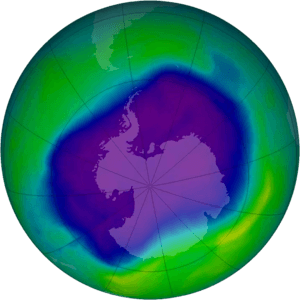Ozone depletion facts for kids

Ozone is a special gas found high up in Earth's atmosphere, in a place called the ozone layer. This layer is super important because it acts like Earth's sunscreen. It stops most of the harmful ultraviolet (UV) light from the sun from reaching us. UV light can be bad for living things.
Ozone depletion means the ozone layer is getting thinner. This has been happening since the 1970s. We've seen about a 4% drop in ozone every ten years. Also, during springtime, especially over the South Pole, the ozone layer gets much thinner. This is what we call the ozone hole.
Scientists found that certain man-made chemicals are causing this problem. These chemicals are called halocarbons, like CFCs (also known as freons) and halons. They were used in things like refrigerators and spray cans. When these chemicals get into the atmosphere, they break down the ozone.
Contents
What Causes Ozone Depletion?
The main reason the ozone layer is getting thinner is because of chemicals called ozone-depleting substances (ODS). These include CFCs, halons, carbon tetrachloride, and trichloroethane.
How Chemicals Harm Ozone
When these chemicals are released, they slowly travel up into the stratosphere. Once there, sunlight breaks them apart. This releases tiny particles called halogen atoms. These halogen atoms then act like tiny wrecking balls, destroying ozone molecules. One halogen atom can destroy many ozone molecules.
The Ozone Hole Explained
The "ozone hole" is not really a hole. It's an area where the ozone layer becomes extremely thin. This happens mostly over the North and South Poles during their spring seasons. Cold temperatures and special clouds over the poles help these chemicals destroy ozone even faster.
Why Is the Ozone Layer Important?
The ozone layer protects all life on Earth from harmful UV light. Without it, more UV light would reach the ground.
Impacts on People and Animals
Too much UV light can cause serious health problems for humans. It can lead to more skin cancer and damage our eyes, causing cataracts. Animals can also be harmed by increased UV radiation.
Impacts on Plants and Oceans
Plants can be damaged by too much UV light, which can affect how they grow. In the ocean, tiny living things called plankton are very important for the food chain. If plankton populations shrink because of UV light, it can affect all the animals that eat them, including fish and whales.
Working Towards Recovery
Because of the serious concerns about ozone depletion, countries around the world decided to act.
The Montreal Protocol
In 1987, many countries signed an important agreement called the Montreal Protocol. This treaty agreed to stop making and using ozone-depleting chemicals like CFCs and halons. It was a big step towards protecting our planet.
When Will the Ozone Layer Heal?
Thanks to the Montreal Protocol, the ozone layer is slowly starting to recover. However, it will take a long time because the chemicals stay in the atmosphere for many years.
- Scientists from NASA think the ozone layer over Antarctica might get back to its normal level (before 1980) by around 2068.
- The World Meteorological Organization believes the Antarctic ozone layer will recover between 2060 and 2075.
- For the Arctic regions, the ozone layer is expected to recover sooner, around 2050.
It's a great example of how countries can work together to solve a global environmental problem.
Images for kids
See also
 In Spanish: Agujero de la capa de ozono para niños
In Spanish: Agujero de la capa de ozono para niños








